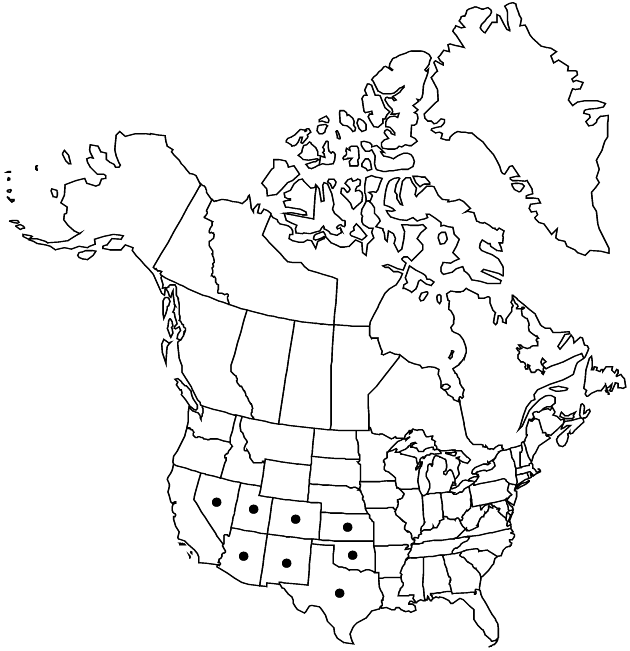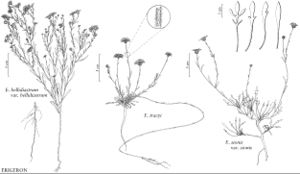Erigeron tracyi
Pittonia 5: 59. 1902.
Annuals, biennials, or short-lived perennials, 2.5–8 (–12, 18) cm; usually taprooted, sometimes fibrous-rooted, caudices simple or branched. Stems first erect (greenish proximally), then producing herbaceous, leafy, prostrate runners (stoloniform branches, sometimes with rooting plantlets at tips), densely hirsutulous (hairs spreading-deflexed, of relatively even lengths and orientations), sparsely minutely glandular. Leaves mostly basal (persistent in early season); blades oblanceolate to spatulate (obovate-elliptic laminae), 10–30 (–60) × 3–6 (–12) mm, cauline abruptly reduced distally, margins entire, dentate, or lobed, faces densely hirsute, eglandular. Heads 1 (–3 rarely, from midstem or proximal branches). Involucres 3.5–4.5 (–6) × 6–9 (–12) mm. Phyllaries in 3–4 series, sparsely to moderately hirsute, minutely glandular. Ray-florets 60–130; corollas white, often purplish abaxially, sometimes with an abaxial midstripe, 5–9 mm, laminae not coiling or reflexing. Disc corollas 2–3 mm (throats indurate and slightly inflated). Cypselae 0.7–1.3 mm, 2-nerved, faces sparsely strigose; pappi: outer of setae, inner of 12–16 bristles. 2n = 27.
Phenology: Flowering Mar–Oct.
Habitat: Desert scrub, grassy slopes, oak chaparral, pinyon-juniper woodlands, Douglas fir-ponderosa pine
Elevation: 700–2300(–2400) m
Distribution

Ariz., Colo., Kans., Nev., N.Mex., Okla., Tex., Utah, Mexico (Baja California), Mexico (Chihuahua), Mexico (Coahuila), Mexico (Durango), Mexico (Sonora), Mexico (Zacatecas)
Discussion
In March through June, plants of Erigeron tracyi produce leaves in a basal rosette usually with a single, erect, monocephalous, stem. Stoloniform branches are soon formed (often recognized on pressed specimens by the leaves mostly on one side of the branches), and by the end of the season (August through October), prostrate runners are usually evident, sometimes forming terminal, rooting plantlets.
Erigeron tracyi is similar in habit to E. flagellaris, particularly in the herbaceous stolons or stoloniform branches; the stem pubescence of E. tracyi is different, the stolons much less commonly produce rooting plantlets at the tips, and the plants tend to be perennial with woody or lignescent caudices, although they are variable both in habit and duration. Apparent hybrids with E. modestus and E. flagellaris are occasionally encountered, and the most common form of E. tracyi is perhaps (speculative) a stabilized, apomictic hybrid between the latter and E. divergens. All chromosome counts thus far have shown E. tracyi to be triploid and asynaptic.
Selected References
None.
